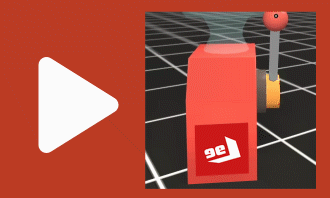- Log in to post comments
The tents in Salzburg's Volksgarten have already been taken down, and the computers and scanners have been packed away. A week after the end of Mini-Salzburg, the children's city, not much remains to be seen. It's time to take stock!
For three weeks, we – the team from Augmented Reality Communities and the Artificial Museum – brought our Mars Mission and Science Fiction Lab to Mini-Salzburg. Over the course of 14 playdays, an incredible 124 utopias, or cities on Mars, were created. But let's take it step by step and begin the recap from the start:
The First Days
We started setting up on the first of July. The workflow was tested, and all devices were charged and ready to go. In total, we worked with three laptops, a flatbed scanner, a photo booth with a webcam, three smartphones, two tablets, five pairs of headphones, a label printer, and a laminating machine. For the design of our station, we also had silver-reflective tablecloths, two roll-ups, a banner, a Mars globe, and lots of posters. The Mars Mission was ready to launch!
On Tuesday, the second of July, the play began.
“Do you have any spots left?”
“Yes, we do!”
“What can I do here?”
“With us, you can build your own city on Mars.”
First, participants had to fill out an astronaut ID. Then, groups were formed, and the children chose a name for their city and designed a flag. Next came object design: Hand-drawn objects were scanned in the photo booth and transformed into 3D objects using two artificial intelligence tools. These objects could then be placed, scaled, and rotated on a virtual Martian surface using an adapted editor. As a grand finale, the utopia could be viewed and evaluated in augmented reality. Once everything was finalized, the children received a QR code that allowed them to open a portal to Mars and their utopia from anywhere (provided they had an AR-compatible device with internet access).
Flow Despite the Heat
During the first week of play, we were able to fix minor bugs and workflow issues. By the second week, operations ran (almost) without a hitch. At times, the children managed the entire station themselves – all we could do was watch in awe. From filling out children's city passports and study certificates to explaining the workflows and communicating with Mini-Salzburg media, the children took full responsibility for their Mars Mission.
The days were long, and the sun often beat down mercilessly on the roof of our pagoda. A few clouds and a bit of rain were a welcome change. But no matter the weather, the children were motivated and enthusiastic, and the operations at the children's city and our station rarely came to a halt. The three weeks flew by, yet at the same time, they felt like half a year – anyone who has been involved in the children's city will likely recognize this distorted sense of time.
What Remains?
We are currently processing the children's city experience for our research project. Was technology a hindrance or a help in dreaming and imagining utopias? How did transforming their own drawings into digital 3D objects affect the children's creativity? In what ways is it empowering to use digital tools to shape one's environment? Possible answers to these and many other questions are swirling in our minds and need to be sorted. We expect to share initial results in the fall. What we can already share is an overview of the statistics:
Hard Facts
- 124 utopias (cities on Mars)
- 1103 3D models
- 9290 Stable Diffusion 2.5D images
The Best Comes Last
At our station, we had a logbook where children could leave feedback for us. Here are some of their entries:
- “I think it's cool that you can just let your imagination run wild here. This station is intentionally the best.”
- “It was very fun, and you learn a lot. It's great fun for young and old alike.”
- “I think it’s very great to work here, and I give you my feedback from the bottom of my heart.”
- “It should be noted that the heads of the 3D models were dented, holey, or almost nonexistent.”
The creativity of the children in naming their Mars cities is evident in examples like these (among many others!):
- Lamborghini Hundeheim
- Marsa Melonia Zitronia
- Die Elien Baster
- GluRaup
- Käsebande
- Lumilia
- and many more.
All Mars cities can now be explored and admired using an AR-compatible device: https://kinderstadt.goldextra.com/






